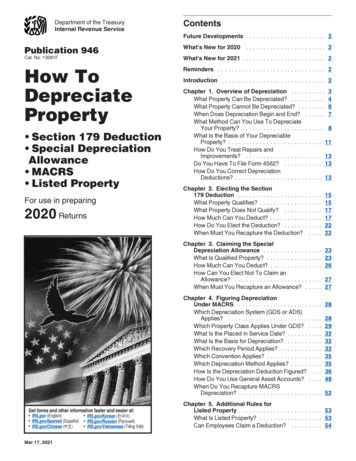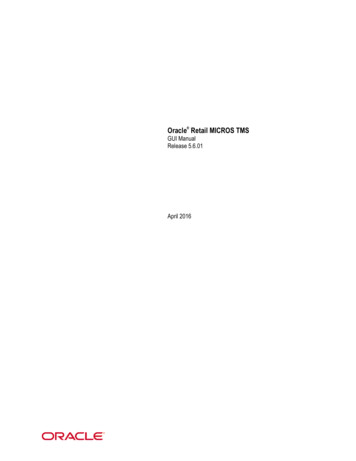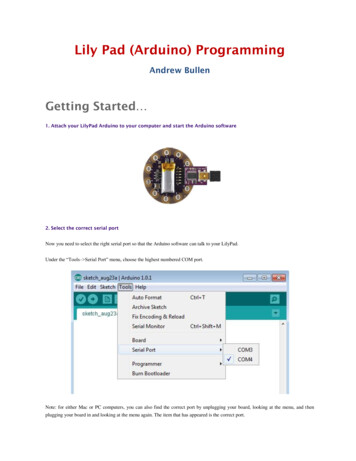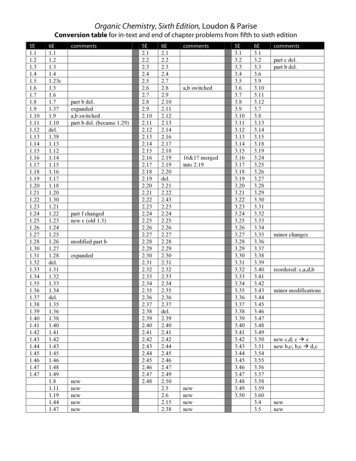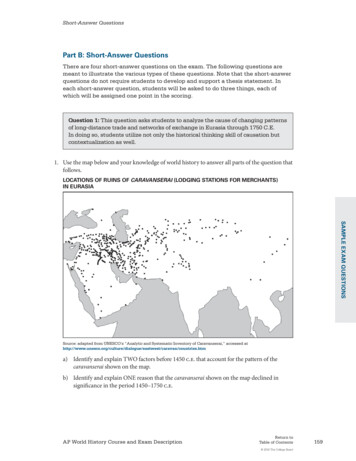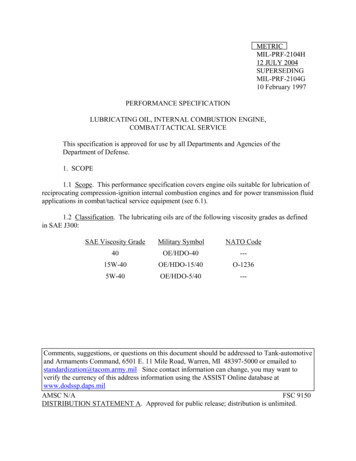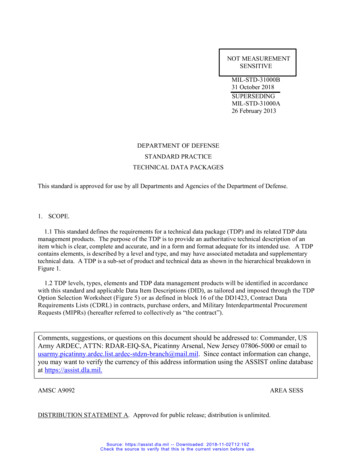
Transcription
NOT MEASUREMENTSENSITIVEMIL-STD-31000B31 October 2018SUPERSEDINGMIL-STD-31000A26 February 2013DEPARTMENT OF DEFENSESTANDARD PRACTICETECHNICAL DATA PACKAGESThis standard is approved for use by all Departments and Agencies of the Department of Defense.1. SCOPE.1.1 This standard defines the requirements for a technical data package (TDP) and its related TDP datamanagement products. The purpose of the TDP is to provide an authoritative technical description of anitem which is clear, complete and accurate, and in a form and format adequate for its intended use. A TDPcontains elements, is described by a level and type, and may have associated metadata and supplementarytechnical data. A TDP is a sub-set of product and technical data as shown in the hierarchical breakdown inFigure 1.1.2 TDP levels, types, elements and TDP data management products will be identified in accordancewith this standard and applicable Data Item Descriptions (DID), as tailored and imposed through the TDPOption Selection Worksheet (Figure 5) or as defined in block 16 of the DD1423, Contract DataRequirements Lists (CDRL) in contracts, purchase orders, and Military Interdepartmental ProcurementRequests (MIPRs) (hereafter referred to collectively as “the contract”).Comments, suggestions, or questions on this document should be addressed to: Commander, USArmy ARDEC, ATTN: RDAR-EIQ-SA, Picatinny Arsenal, New Jersey 07806-5000 or email ail.mil. Since contact information can change,you may want to verify the currency of this address information using the ASSIST online databaseat https://assist.dla.mil.AMSC A9092AREA SESSDISTRIBUTION STATEMENT A. Approved for public release; distribution is unlimited.Source: https://assist.dla.mil -- Downloaded: 2018-11-02T12:19ZCheck the source to verify that this is the current version before use.
MIL-STD-31000BTechnical Data Package (TDP)(includes but is not limited to):ModelsDrawingsAssociated ListsSpecificationsStandardsQuality Assurance ProvisionsSoftware DocumentationPackaging DetailsFIGURE 1. TDP relationships2. APPLICABLE DOCUMENTS.2.1 General. The documents listed in this section are specified in sections 3, 4 and 5 of this standard. Thissection does not include documents listed in other sections or recommended for additional information or asexamples. While every effort has been made to ensure the completeness of this list, document users arecautioned that they must meet all specified requirements of documents cited in sections 3, 4, or 5 of thisstandard, whether or not they are listed.2.2 Government documents.2.2.1 Specifications, standards, and handbooks. The following specifications, standards, andhandbooks form a part of this document to the extent specified herein. Unless otherwise specified, theissues of these documents are those cited in the solicitation or contract.2Source: https://assist.dla.mil -- Downloaded: 2018-11-02T12:19ZCheck the source to verify that this is the current version before use.
MIL-STD-31000BDEPARTMENT OF DEFENSE STANDARDS.MIL-STD-961Defense and Program-unique Specifications Format and ContentMIL-STD-963Data Item Descriptions (DIDs)MIL-STD-2073-1 Standard Practice for Military PackagingDOD-STD-2101Classification of CharacteristicsCopies of these documents are available online at http://quicksearch.dla.mil.2.2.2 Other Government documents and publications. The following other Government documentsand publications form a part of this document to the extent specified herein. Unless otherwise specified,the issues are those cited in the solicitation or contract.DEPARTMENT OF DEFENSE MANUALSDoD Manual 4100.39-MFederal Logistics Information System (FLIS) ProceduresDoD Manual 5220.22-MDoD Industrial Security Manual for Safeguarding Classified Information.DoD Instruction 5230.24Distribution Statements on Technical DocumentsDoD Directive 5230.25Withholding of Unclassified Technical Data From Public DisclosureDFARS Part 252DFAR Supplement for Solicitations, Provisions and Contract ClausesDFARS 252.227-7013Rights in Technical Data--Noncommercial Items.DFARS 252.227-7014Rights in Noncommercial Computer Software and NoncommercialComputer Software Documentation.(Applications for copies of DoD Manual 5520.22-M and DoD Instruction 5230.24 are available from theDefense Technical Information Center (DTIC), http://www.dtic.mil. Copies of DFARS documents areavailable online at index.html. The federal documentscan be found at http://www.dtic.mil/whs/directives/.)FEDERAL PUBLICATIONFederal Standardization Manual(Copies of Federal Standardization Manual are available from the General Service Administration,Centralized Mailing List Service (7CAFL), P.O. Box 6477, Ft. Worth, TX 76115 ame/Federal Standardization Manual.action.)2.3 Non-Government publications. The following documents form a part of this standard to theextent specified herein. Unless otherwise specified, the issues of the documents are those cited inthe solicitation.3Source: https://assist.dla.mil -- Downloaded: 2018-11-02T12:19ZCheck the source to verify that this is the current version before use.
MIL-STD-31000BAMERICAN SOCIETY OF MECHANICAL ENGINEERS (ASME)ASME Y14.1Decimal Inch Drawing Sheet Size and FormatASME Y14.1MMetric Drawing Sheet Size and FormatASME Y14.24Types and Applications of Engineering DrawingsASME Y14.34Associated ListsASME Y14.35Revision of Engineering Drawings and Associated DocumentsASME Y14.41Digital Product Definition Data PracticesASME Y14.5Dimensioning and TolerancingASME Y14.100Engineering Drawing Practices(Copies of these documents are available from https://www.asme.org/ or ASME information CentralOrders/Inquiries, P.O. Box 2300, Fairfield, NJ 07007-2300)INSTITUTE OF ELECTRICAL AND ELECTRONICS ENGINEERS (IEEE)ISO/IEC 12207ISO 32000-1System and Software Engineering - Software Lifecycle ProcessesDocument Management - Portable Document Format.(Copies of this document are available from http://www.ieee.org/index.html, or IEEE Service Center, 445Hoes Lane, P.O. Box 1331, Piscataway, NJ 08854-1331.)AMERICAN NATIONAL STANDARDS INSTITUTE (ANSI)ISO 10303 Standard for the Exchange of Product model data (STEP)(Copies of free and purchased parts of the standard are available at: https://www.iso.org/.)NATIONAL AEROSPACE STANDARDS (NAS)NAS 3500 Technical Data Package: Composition, Communication, and Application(Copies of this document are available from the Aerospace Industries Association of America, inc. 1000WILSON BLVD, ARLINGTON, VA 22209 and http://www.aia-aerospace.org.)2.4 Order of precedence. Unless otherwise noted herein or in the contract, in the event of a conflictbetween the text of this document and the references cited herein, the text of this document takesprecedence. Nothing in this document, however, supersedes applicable laws and regulations unless aspecific exemption has been obtained.4Source: https://assist.dla.mil -- Downloaded: 2018-11-02T12:19ZCheck the source to verify that this is the current version before use.
MIL-STD-31000B3. DEFINITIONS.3.1 For the purposes of this standard, the following definitions apply:3.1.1 3-Dimensional Intelligent (3Di) technical data. A 3-dimensional viewable representation of anitem provided in a widely available software format (e.g. ISO 32000-1 Portable Document Format(PDF)). This representation details the complete technical description of the required designconfiguration to include but not limited to geometry, topology, relationships, tolerances, attributes,metadata and other features necessary to define a component or assembly.3.1.2 3Di format. The standard arrangement and organization of information within a 3Di viewablerepresentation of an item. This includes such features as the size and arrangement of information blocks(e.g. title blocks), notes, lists, revision information, view states, restriction notices and the use of optionalor supplemental blocks (see related term Drawing Format).3.1.3 Commercial And Government Entity (CAGE) code. A five character alpha-numeric identifier,assigned to commercial and Government activities that manufacture or develop items, or provide servicesor supplies for the Government. When used with a document number or part number, the CAGE codedesignates the design activity from whose series the document or part number is assigned.3.1.4 Commercial engineering design data. Engineering design data prepared by a commercialdesign activity, in accordance with that activity's documentation standards and practices, to support thedevelopment and manufacture of a commercially developed product.3.1.5 Commercial item. An item that is customarily used by or sold to the general public or by nongovernmental entities for purposes other than governmental purposes.3.1.6 Company standard. A company document, which establishes engineering and technicallimitations and applications for items, materials, processes, methods, designs and engineering practicesunique to that company. (NOTE: Company standards are not considered to be non-Governmentstandards.)3.1.7 Competent manufacturer. A manufacturer that has demonstrated the capability to producesimilar products at the same state of the art in the same or similar lines of technology.3.1.8 Computer software. Computer programs, source code, source code listings, object codelistings, design details, algorithms, processes, flow charts, formulae and related material that wouldenable the software to be reproduced, recreated, or recompiled. Computer software does not includecomputer data bases or computer software documentation. (DFARS Clause 252.227-7014)3.1.9 Computer software documentation. Owner’s manuals, user’s manuals, installationinstructions, operating instructions, and other similar items, regardless of storage medium, that explainthe capabilities of the computer software or provide instructions for using the software. (DFARS Clause252.227-7014) ISO/IEC Standard 12207 uses the term “software life cycle data” to address softwaredocumentation.3.1.10 Configuration Item (CI). A product or an aggregation of products that accomplishes an enduse function and is deemed to require separate configuration management documentation and control.Configuration items are end items or major components of end items, which typically have performancerequirements allocated to them and documented in their own specification.5Source: https://assist.dla.mil -- Downloaded: 2018-11-02T12:19ZCheck the source to verify that this is the current version before use.
MIL-STD-31000B3.1.11 Critical manufacturing process. A process that is the only known manufacturing method thatwill result in the production of an acceptable item.3.1.12 Data Item Description (DID). A completed document defining the data deliverables requiredof a DOD contractor. A DID specifically defines the data content, format and intended use of the datawith a primary objective of achieving standardization of data deliverables by the DOD. (MIL-STD-963)3.1.13 Design activity. An organization that has, or has had, responsibility for the design of an item.The two types of design activity are:3.1.13.1 Current Design Activity (CDA). The design activity currently responsible for the designof an item. This may be the original design activity or a design activity to which the design responsibilityhas been transferred.3.1.13.2 Original Design Activity (ODA). The design activity originally responsible for the designof an item, and whose design activity identification (CAGE Code) is associated with the part oridentifying number (PIN) and are typically shown in the title block of the engineering design data.3.1.14 Detail specification. A specification that specifies design requirements, such as materials tobe used, how a requirement is to be achieved, or how an item is to be fabricated or constructed. (MILSTD-961)3.1.15 Drawing. An engineering document or digital data file(s) that discloses (directly or byreference), by means of graphic or textual presentations, or by combinations of both, the physical orfunctional requirements of an item. (ASME Y14.100) A drawing is a type of engineering design data.3.1.16 Drawing format. The arrangement and organization of information within a drawing. Thisincludes such features as the size and arrangement of blocks, notes, lists, revision information, and theuse of optional or supplemental blocks. (ASME Y14.1/Y14.1M) (See related term 3Di format)3.1.17 End product. An end product is an item, such as an individual part or assembly, in its final orcompleted state. (ASME Y14.24). An end product is also known as an end item.3.1.18 Engineering design data. Engineering drawings, 3Di viewables, native CAD models, neutralCAD models or a combination of these, which define an item by means of graphic and textualpresentations, the physical and/or functional requirements of an item, sufficient to fulfill its TDP elementand level requirements. Engineering design data comes in three levels corresponding to its TDP levelrequirements as defined below:3.1.18.1 Conceptual design data. Engineering design data which describe the engineeringconcepts on which a proposed technology or design approach is based.3.1.18.2 Developmental design data. Engineering design data which describe the physical and/orperformance characteristics of a specific design approach to the extent necessary to permit the analyticalevaluation of the ability of the design approach to meet specified requirements and enable thedevelopment, manufacture and testing of prototype or experimental materiel.3.1.18.3 Product design data. Engineering design data which describes the complete physicaland/or performance characteristics of an item or component in sufficient detail to ensure that an item or6Source: https://assist.dla.mil -- Downloaded: 2018-11-02T12:19ZCheck the source to verify that this is the current version before use.
MIL-STD-31000Bcomponent produced in accordance with this data will be essentially identical to the original item orcomponent.3.1.19 Fully annotated model. A 3D CAD dataset, in which all necessary features to fully define theitem (i.e. full design disclosure to include dimensions, tolerances, materials, notes, surface finishes, etc.)are included in a readily viewable form. (See ASME Y14.41)3.1.20 Limited design disclosure model. A 3D CAD dataset sufficiently defined to provide a visualunderstanding of the item, but which does not contain full design disclosure. Generally externalinterface characteristics and features such as weight and center of gravity will be sufficiently defined forthe intended purpose. Sometimes referred to as an envelope model, shrink-wrap model or cosmeticmodel.3.1.21 Metadata. Data that provides information about other data. For the purpose of this standard,metadata is defined to be data about a design and/or engineering design documents. (Part number, drawingnumber, nomenclature, revision, date approved, approved by, used on, etc., are examples of metadata).Metadata is used by the design and procuring activities to store, manage, and provide access to TDPelements.3.1.22 Model Based Definition (MBD). The practice of using 3D datasets containing the exact solidrepresentation, associated 3D geometry and 3D annotations of a product’s dimensions, tolerances,materials, finishes and other notes to specify a complete product definition. (See ASME Y14.41)3.1.23 Non-Government standardization document (a.k.a. Industry Standards). A standardizationdocument developed by a private sector association, organization or technical society which plans,develops, establishes or coordinates standards, specifications, handbooks or related documents. Thesedocuments are available for purchase or free of charge to the general public. Company standards are notconsidered as non-Government standardization documents.3.1.24 Performance specification. A specification that states requirements in terms of the requiredresults with criteria for verifying compliance, but without stating the methods for achieving the requiredresults. A performance specification defines the functional requirements for the item, the environment inwhich it must operate, and interface and interchangeability characteristics. (MIL-STD-961)3.1.25 Procuring activity. The Government or private organization which establishes therequirements for an end item, service or set of data, and is responsible for the issuance of a contract orsolicitation for these goods or services.3.1.26 Product Lifecycle Management (PLM). The process or system used for managing productrelated design, production and maintenance information. PLM systems are typically softwareapplications designed for the purpose of lifecycle management of a product.3.1.27 Quality Assurance Provisions (QAP). Documented requirements, procedures and criterianecessary for demonstrating that products conform to design requirements.3.1.28 Reference documents. Documents referred to in a TDP element, which contain informationnecessary to meet the information content requirements of that TDP element.3.1.29 Software specification. A type of program-unique specification that describes therequirements and verification of requirements for the automatic acquisition, storage, manipulation,7Source: https://assist.dla.mil -- Downloaded: 2018-11-02T12:19ZCheck the source to verify that this is the current version before use.
MIL-STD-31000Bmanagement, movement, control, display, switching, interchange, transmission, or reception of data orinformation. (MIL-STD-961)”3.1.30 Special Inspection Equipment (SIE). Either single or multi-purpose integrated test unitsengineered, designed, fabricated or modified to perform special purpose testing of an item in themanufacturing process. It consists of items or assemblies of equipment and associated software that areinterconnected and interdependent so as to become a new functional entity for inspection or testingpurposes. SIE is also known as special test equipment.3.1.31 Special Packaging Instruction (SPI). Instructions which document military packagingrequirements for an item, as distinct from commercial packaging. These instructions cover methods ofpreservation to protect materiel against environmentally induced corrosion and deterioration, physical andmechanical damage, and other forms of degradation during storage, multiple handling and shipment ofmateriel in the defense transportation system. SPI’s will be required and prepared in accordance withAppendix E of MIL-STD-2073-1 and as specified in the contract and Contract Data Requirements List(CDRL).3.1.32 Special tooling. Unique tooling which is mandatory for the manufacture of an acceptableitem. It differs from tooling designed to increase manufacturing efficiency in that the use of the specialtool imparts some characteristic to the item which is necessary for satisfactory performance and cannot beduplicated through other generally available manufacturing methods. Examples of special tooling wouldbe jigs, dies, fixtures, molds, patterns and other equipment or manufacturing aids that absolutely must beused in order to produce a satisfactory item.3.1.33 Specification. A document that describes essential technical requirements for materiel and thecriteria for determining whether those requirements are met. (MIL-STD-961)3.1.34 Standardization document. A document, such as a specification, standard or handbook,developed for the purpose of standardizing items, materials, processes or procedures.3.1.35 Supplementary technical data. Data related to or in support of a TDP, but not an inherent partof the TDP, which is provided as reference material or is explanatory in nature. For example,supplementary technical data for a particular item could include manufacturing instructions, simulations,work flow data, inspection equipment or procedures (which are not required as an inherent part of theTDP or TDP element), manufacturing machine code, design studies, analysis studies, test results, safetydata sheets, etc.3.1.36 Technical data. Recorded information, regardless of the form or method of the recording, of ascientific or technical nature (including computer software documentation). The term does not includecomputer software or data incidental to contract administration, such as financial or managementinformation. (DFARS Clause 252.227-7013).3.1.37 Technical data CAD format:3.1.37.1 Native CAD data. CAD data as created in its original authoring software format. Ingeneral, only the original authoring software format is capable of reading, editing and interpreting nativeCAD data. (Examples: CREO, CATIA, Autodesk, SolidWorks, etc.) Generally native CAD data is theonly format suitable to serve as master technical data. Native CAD data may also serve as authoritativetechnical data.8Source: https://assist.dla.mil -- Downloaded: 2018-11-02T12:19ZCheck the source to verify that this is the current version before use.
MIL-STD-31000B3.1.37.2 Neutral CAD data. CAD data which is derived from the native format and converted intoa format which can be imported into other CAD software. Neutral CAD data is created to a widelyavailable national or international standard (e.g. STEP). In general, neutral CAD data cannot serve asmaster technical data but may serve as either reference or authoritative technical data.3.1.37.3 Viewable CAD data. CAD data which is derived from the native format and convertedinto a format which can be displayed by a widely available software and for purposes of defining designintent in a human readable format (e.g. 3Di PDF). In general, viewable CAD data cannot serve as mastertechnical data but may serve as either reference or authoritative technical data.3.1.38 Technical data origin:3.1.38.1 Master technical data. A set of technical data which is the controlling source for anysubsequent technical data output. All changes to the technical data must originate on the master technicaldataset. There can be only one instance of the master technical data which is typically in the native CADformat and maintained by the current design activity.3.1.38.2 Derivative technical data. A set of technical data generated from master technical data.Typically derivative technical data is created to change its format to suit a different purpose. Forexample converting master, native format data to neutral or viewable data (e.g. STEP, PDF, etc.) so as toallow it to be read by a wider range of software applications. Changes to derivative technical dataoriginate on the master technical dataset.3.1.39 Technical data validation status:3.1.39.1 Authoritative technical data. A set of technical data which has been released andvalidated as adequate and complete for its intended purpose.3.1.39.2 Reference technical data. A set of technical data which is provided for information, butis not necessarily validated as accurate, adequate and complete.3.1.40 Technical Data Package (TDP). The authoritative technical description of an item. Thistechnical description supports the acquisition, production, inspection, engineering, and logistics supportof the item. The description defines the required design configuration and/or performance requirements,and procedures required to ensure adequacy of item performance. It consists of applicable technical datasuch as models, engineering design data, associated lists, specifications, standards, performancerequirements, quality assurance provisions, software documentation and packaging details.3.1.41 Technical data package data management product. A data product that is used to monitor andcontrol the development and maintenance of the TDP. A TDP data management product containsinformation about the TDP rather than the item being documented.3.1.42 Technical data package element (a.k.a. component). A data product that is an actualcomponent of the TDP. A TDP element provides all or part of the information necessary to define theitem being documented by the TDP. All TDP elements taken collectively provide a complete TechnicalData Package.3.1.43 Technical Data Package List (TDPL). An index of all documents contained in a technicaldata package established at a point in time. TDPLs contain a list of all specifications, engineering designdata, (i.e. drawings, models, 3Di viewables, etc.), QAPs, inspection documents, packaging documents, orother documents which comprise the TDP listed by nomenclature, document CAGE code, documentnumber, distribution statement, revision, and date.9Source: https://assist.dla.mil -- Downloaded: 2018-11-02T12:19ZCheck the source to verify that this is the current version before use.
MIL-STD-31000B3.1.44 Verification. All examinations, tests and inspections necessary to verify that an item meetsthe physical and functional requirements for which it was designed, to verify that a component, part orsubassembly will perform satisfactorily in its intended application, or that an item conforms to specifiedrequirements.10Source: https://assist.dla.mil -- Downloaded: 2018-11-02T12:19ZCheck the source to verify that this is the current version before use.
MIL-STD-31000B4. GENERAL REQUIREMENTS.4.1 General. The purpose of the TDP is to provide a technical description of an item which is clear,complete and accurate and in a form and format adequate for its intended use. TDPs define the physicaland functional characteristics of the accepted configuration of the item and its subordinate assemblies,subassemblies, and parts. To accomplish this purpose, TDPs consist of a level and type and one or moreelements as specified in the contract and TDP Option Selection Worksheet. In addition, TDP metadata,supplementary data and TDP data management products may be required to manage and control theTDP development process as specified in the contract and TDP Option Selection Worksheet (Figure 5).4.2 TDP levels. TDP levels provide for a natural progression of a design from its inception toproduction. A particular TDP level may be ordered to define a conceptual design, a developmentalprototype or limited production design, or full scale production of the item by the original designactivity or any other capable manufacturer. TDPs consist of one of three Levels:(1) Conceptual Level(2) Developmental Level(3) Product Level4.3 TDP types. TDP type describes the form and format of the technical data and shall consist ofone or more of the following types:4.3.1 Type 2D: 2-Dimensional (2D) Technical Data Package.4.3.2 Type 3D: 3-Dimensional (3D) Technical Data Package. Type 3D will include one ormore of the below as specified in the contract and TDP Option Selection Worksheet:(1) 3D native models.(2) 2D drawings derived from the 3D native models.(3) 3Di pdf viewable data derived from the 3D native models.(4) Neutral files derived from the 3D native models.4.4 TDP elements. TDP elements describe the various components of the TDP. TDP elementsshall consist of some or all the following as necessary to fulfill its intended purpose and as describedin the contract and TDP Option Selection Worksheet.4.4.1 Engineering design data. The form and format of the engineering design data, whether it be2D drawings, 3Di viewables, native or neutral CAD data, will be as specified in the TDP OptionSelection Worksheet and the contract. The engineering design data may consist of conceptual,developmental or product level engineering design data depending on the TDP level requirements andmay be in government or commercial format as stated in the contract and TDP Option SelectionWorksheet.a. Special Inspection Equipment (SIE) engineering design data and associated lists.b. Specifications.c. Software documentation.d. Special Packaging Instruction (SPI) documents, engineering design data and associated lists.e. Quality assurance provisions (QAP).f. Special Tooling engineering design data and associated lists.11Source: https://assist.dla.mil -- Downloaded: 2018-11-02T12:19ZCheck the source to verify that this is the current version before use.
MIL-STD-31000B4.5 TDP data management products. TDP data management products listed below are used by theprocuring activity to control and manage the TDP development process and shall be delivered in accordancewith the contract and TDP Option Selection Worksheet. Other TDP data management products in additionto those listed below may also be required as stated in the contract.a. Technical Data Package List (TDPL).b. Document number assignment report.c. Proposed critical manufacturing process description.d. Source control approval request.e. Engineering drawing tree4.6 TDP metadata. Metadata consist of data from and about TDP elements and is used by theprocuring activity to manage the TDP development process and to better acquire and support the endproduct defined by the TDP. When metadata is required, it shall be delivered in accordance with thecontract.4.7 Supplementary technical data. TDP supplementary technical data are deliverable data productsused by the procuring activity to better acquire and support the end product defined by the TDP. Whensupplementary technical data is required, it shall be delivered in accordance with the contract.5. DETAILED REQUIREMENTS.5.1 General. TDPs define the physical and functional characteristics of the accepted configuration ofthe item and its subordinate assemblies, subassemblies, and parts. See Appendix A for guidance onselection of TDP elements and data management products.5.2 TDP levels.5.2.1 Conceptual level. A conceptual TDP shall consist of those TDP elements necessary to definedesign concepts, and include the appropriate information required for analysis and evaluation of thoseconcepts. The data will generally consist of simple sketches/models, artist renderings and/or basic textualdata. The data may consist of the system performance specification (see 5.4.4) and conceptual designdata (see 5.4.1.1) as specified by the contract.5.2.2 Developmental level.
Oct 31, 2018 · ASME Y14.1M Metric Drawing Sheet Size and Format ASME Y14.24 Types and Applications of Engineering Drawings ASME Y14.34 Associated Lists ASME Y14.35 Revision of Engineering Drawings and Associated Documents ASME Y14.41 Digital Product Definition Data Practices ASME Y14.5 Dimensioning and Tolera
